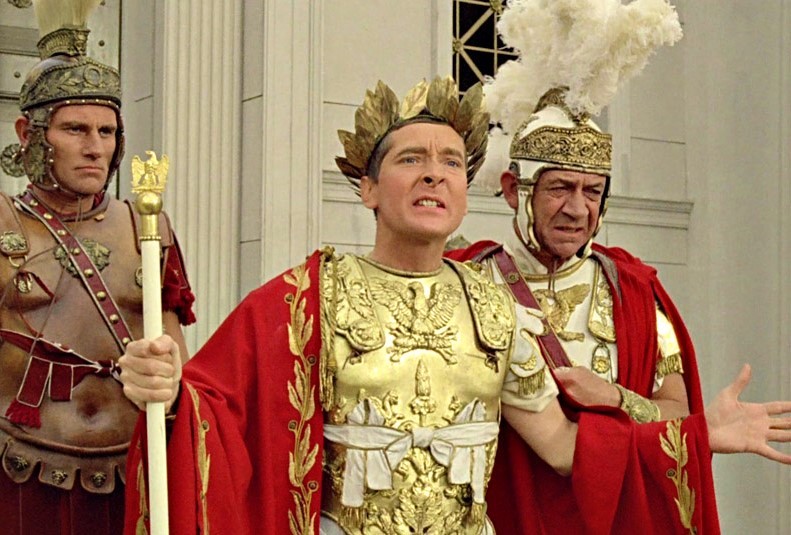So if you are going to quote famous British comedic icon Kenneth Williams (playing Julius Caesar in Carry On Cleopatra) to start a blog on safety leadership you probably should have a better reason than the fact that for some strange reason he somehow always reminded you of your awesome Aunt Mog.
Thankfully a bit of poetic licence goes a long way and when our Behavioural Safety consultants run our Leadership in Safety workshops (https://www.lattitudesafety.co.uk/workshops/leadership-in-safety-giants/) we often use an exercise asking trainees to suggest examples of successful leaders.
As you can imagine many of the usual candidates emerge: Barack Obama, Nelson Mandela, Gandhi, Winston Churchill, Mother Theresa, Pep Guardiola (though surprisingly not from Manchester Utd or Real Madrid fans) and more recently Greta Thunberg.
But all too often you get a few unexpected darker more “infamous” (see what we did there?) names emerging. We’ve had the real Julius Caesar (rather than Kenneth Williams), Adolf Hitler, Mr Burns (from the Simpsons) was a surprise as were Genghis Khan and Osama Bin Laden.
Okay, so I know what you’re thinking “there’s always one” in every corporate training room in every country. The obtuse trainee who really really doesn’t want to be there and has decided to make the poor trainer pay for putting them through training clearly below their pay grade. And in the case of Mr Burns you’d probably be right.
However, we have seen enough of these suggestions to realise that there is more behind this than simple mischievous intent. In fact, this happens often enough for us to come to the conclusion that many people see leadership as primarily about strong, ruthless leaders who’ll stop at nothing to achieve their ambition.
But if you have ever been tempted to share that view you have to ask yourself one question. Would you really want any of these infamous leaders responsible for the safety and well-being of your workplace?
Certainly we’d hope that a real-life Mr Burns wouldn’t be most people’s choice to run a nuclear power station.
So what do we feel is the key quality a great safety leader needs? Empathy, empathy and then a little more empathy. Because without the ability to put yourself in other people’s shoes or sense their concerns or hopes, you are unlikely to have a great safety leader on your hands. Or indeed any half decent leader.
“Leadership is about empathy.”– Oprah Winfrey
A few years back we produced a safety leadership training programme that was chosen to win first prize at the World Congress on Safety and Health in Istanbul. It was inspired by the animal kingdom’s most empathetic natural leaders. African elephant matriarchs. 
While there are many theories on leadership there is one form of leadership that we all feel comfortable with, one that works in every organisation, that we call Natural Leadership. Natural Leadership is all about empathy, where individuals are chosen and respected by their peer group because they have an ability to make the people around them feel looked after and valued. If you like, the group choose “wise” cultural leaders that they believe best understand and represent the shared values of the group.
Elephants are the animal world’s best exponents of natural leadership. Millions of years of evolution have taught them that a group that feels safe will flourish. Their unique leadership qualities have been revered by many cultures as diverse as the Roman Empire to the Masai tribe in Kenya who believe that the elephant is so like us humans that it must surely have a soul. While elephant leaders know the identity of hundreds of other elephants in different groups, our human leaders sometimes struggle to remember the names of the people they work with.
“Empathy is a quality of character that can change the world.” – Barack Obama
But what does natural safety leadership look like on a daily basis and what is required to make it happen?
Well, as luck would have it, the “elephantine” style of leadership provides quite a simple four-step formula that, if adopted, can provide a simple step towards a world class safety and well-being culture.
Four easy steps to follow to make it happen:
- Vision
- Be There
- Talk
- Act
Vision:
Like any aspect of leadership world class safety has to begin with a vision, a clear goal of what you want to achieve. After all, how can you lead anyone if you don’t know where you are going? This can be quite simple, for example elephant leaders want their group to get enough food and water while staying safe. We may want everyone in our team to stay safe and healthy. The important thing is to share that goal so everyone in the team knows what you want to achieve.
Be there:
Your actions often speak louder than words.
Elephant leaders are always front and centre protecting their group.
It is vital to be involved in safety activities to show how important it is to you. Attend safety training. Have an open door policy so you are always available for safety. Most importantly don’t blame. Operate a just culture.
Elephant leaders always lead by example and always put safeguarding their group at the top of their priority list.
We have all seen people that merely pay lip service to safety. Safety is only important until something urgent comes along.
If you are seen to take a short cut, so will others. You get the level of safety that your actions demonstrate you truly want.
The moment you put productivity before someone’s well-being you will undermine your safety culture. Why chastise someone for losing or damaging their safety equipment, find out why it is happening and help.
Never turn a blind eye. No matter how trivial, if someone is likely to get hurt it is your duty to take action. The alternative is truly unpalatable.
Take every opportunity to demonstrate how important safety is to your team’s overall performance.
Talk:
Talk with the team not to them.
With safety it is all too easy to treat your team like children but very often they will have a better idea about safety in the jobs they carry out day in day out.
Asking for someone’s opinion is always a great way to make them feel valued. Safety is a great way to have a regular dialogue with your team to find out what is really going on. Remember nothing is too trivial. Honest open communication is the key to every successful team.
Making safety a regular topic of conversation will make it front of mind or if you like how we do things around here.
Remember it’s okay to have to have fun with safety communications.
Act
Once you have a team tuned in to safety it is essential that you are seen to take action to meet their concerns.
But don’t worry, no one expects you to have all the answers. But remember NO EXCUSES as when it comes to safety there are no degrees of honesty. You can never turn a blind eye to any safety issue no matter how small.
Deal with the concerns you can as quickly as possible and always communicate what you have done.
Don’t be afraid to be honest if you don’t know the solution but do follow up and ask for any help you may need.
- Vision
- Be There
- Talk
- Act
Follow these four easy steps and you can achieve the same type of natural empathetic safety culture your organisation needs to thrive. More importantly you will have a happy, healthy and motivated team that can achieve remarkable things together without the need for any “infamous” leadership styles around the workplace.
“I think we all have empathy. We may not have enough courage to display it.” – Maya Angelou
By Rob Coyle

